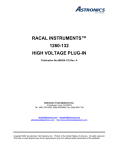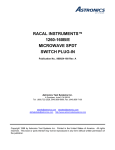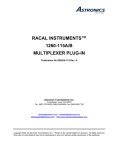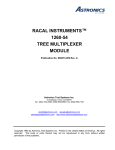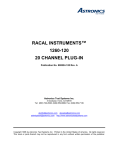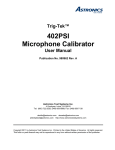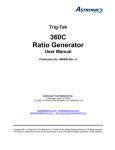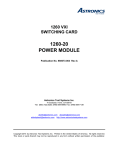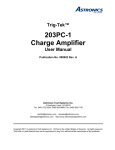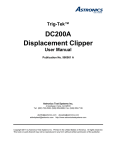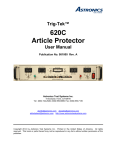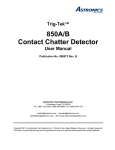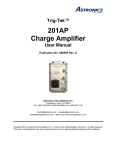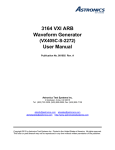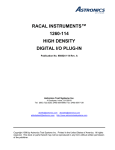Download Manual - Astronics Test Systems
Transcript
RACAL INSTRUMENTS™ 1260-150 10 CHANNEL HIGH FREQUENCY PLUG-IN Publication No. 980824-150 Rev. A Astronics Test Systems Inc. 4 Goodyear, Irvine, CA 92618 Tel: (800) 722-2528, (949) 859-8999; Fax: (949) 859-7139 [email protected] [email protected] [email protected] http://www.astronicstestsystems.com Copyright 1998 by Astronics Test Systems Inc. Printed in the United States of America. All rights reserved. This book or parts thereof may not be reproduced in any form without written permission of the publisher. THANK YOU FOR PURCHASING THIS ASTRONICS TEST SYSTEMS PRODUCT For this product, or any other Astronics Test Systems product that incorporates software drivers, you may access our web site to verify and/or download the latest driver versions. The web address for driver downloads is: http://www.astronicstestsystems.com/support/downloads If you have any questions about software driver downloads or our privacy policy, please contact us at: [email protected] WARRANTY STATEMENT All Astronics Test Systems products are designed to exacting standards and manufactured in full compliance to our AS9100 Quality Management System processes. This warranty does not apply to defects resulting from any modification(s) of any product or part without Astronics Test Systems express written consent, or misuse of any product or part. The warranty also does not apply to fuses, software, non-rechargeable batteries, damage from battery leakage, or problems arising from normal wear, such as mechanical relay life, or failure to follow instructions. This warranty is in lieu of all other warranties, expressed or implied, including any implied warranty of merchantability or fitness for a particular use. The remedies provided herein are buyer’s sole and exclusive remedies. For the specific terms of your standard warranty, contact Customer Support. Please have the following information available to facilitate service. 1. Product serial number 2. Product model number 3. Your company and contact information You may contact Customer Support by: E-Mail: [email protected] Telephone: +1 800 722 3262 (USA) Fax: +1 949 859 7139 (USA) RETURN OF PRODUCT Authorization is required from Astronics Test Systems before you send us your product or sub-assembly for service or calibration. Call or contact Customer Support at 1-800-722-3262 or 1-949-859-8999 or via fax at 1949-859-7139. We can also be reached at: [email protected]. If the original packing material is unavailable, ship the product or sub-assembly in an ESD shielding bag and use appropriate packing materials to surround and protect the product. PROPRIETARY NOTICE This document and the technical data herein disclosed, are proprietary to Astronics Test Systems, and shall not, without express written permission of Astronics Test Systems, be used in whole or in part to solicit quotations from a competitive source or used for manufacture by anyone other than Astronics Test Systems. The information herein has been developed at private expense, and may only be used for operation and maintenance reference purposes or for purposes of engineering evaluation and incorporation into technical specifications and other documents which specify procurement of products from Astronics Test Systems. TRADEMARKS AND SERVICE MARKS All trademarks and service marks used in this document are the property of their respective owners. • Racal Instruments, Talon Instruments, Trig-Tek, ActivATE, Adapt-A-Switch, N-GEN, and PAWS are trademarks of Astronics Test Systems in the United States. DISCLAIMER Buyer acknowledges and agrees that it is responsible for the operation of the goods purchased and should ensure that they are used properly and in accordance with this document and any other instructions provided by Seller. Astronics Test Systems products are not specifically designed, manufactured or intended to be used as parts, assemblies or components in planning, construction, maintenance or operation of a nuclear facility, or in life support or safety critical applications in which the failure of the Astronics Test Systems product could create a situation where personal injury or death could occur. Should Buyer purchase Astronics Test Systems product for such unintended application, Buyer shall indemnify and hold Astronics Test Systems, its officers, employees, subsidiaries, affiliates and distributors harmless against all claims arising out of a claim for personal injury or death associated with such unintended use. FOR YOUR SAFETY Before undertaking any troubleshooting, maintenance or exploratory procedure, read carefully the WARNINGS and CAUTION notices. This equipment contains voltage hazardous to human life and safety, and is capable of inflicting personal injury. If this instrument is to be powered from the AC line (mains) through an autotransformer, ensure the common connector is connected to the neutral (earth pole) of the power supply. Before operating the unit, ensure the conductor (green wire) is connected to the ground (earth) conductor of the power outlet. Do not use a two-conductor extension cord or a three-prong/two-prong adapter. This will defeat the protective feature of the third conductor in the power cord. Maintenance and calibration procedures sometimes call for operation of the unit with power applied and protective covers removed. Read the procedures and heed warnings to avoid “live” circuit points. Before operating this instrument: 1. Ensure the proper fuse is in place for the power source to operate. 2. Ensure all other devices connected to or in proximity to this instrument are properly grounded or connected to the protective third-wire earth ground. If the instrument: - fails to operate satisfactorily shows visible damage has been stored under unfavorable conditions has sustained stress Do not operate until performance is checked by qualified personnel. This page was left intentionally blank. Publication No. 980824-150 Rev. A 1260-150 User Manual Table of Contents Chapter 1 ............................................................................................................................ 1-1 SPECIFICATIONS ........................................................................................................................ 1-1 Introduction ............................................................................................................................... 1-1 Specifications ............................................................................................................................ 1-1 Power Dissipation ...................................................................................................................... 1-3 About MTBF .............................................................................................................................. 1-4 Ordering Information ................................................................................................................. 1-5 Chapter 2 ............................................................................................................................ 2-1 INSTALLATION INSTRUCTIONS ................................................................................................. 2-1 Unpacking and Inspection ......................................................................................................... 2-1 Installation ................................................................................................................................. 2-1 Module Configuration ................................................................................................................ 2-2 Front Panel Connectors ......................................................................................................... 2-4 Channel Mapping ...................................................................................................................... 2-5 Mating Connectors .................................................................................................................... 2-6 Astronics Test Systems i 1260-150 User Manual Publication No. 980824-150 Rev. A Chapter 3 ............................................................................................................................ 3-1 MODULE OPERATION ................................................................................................................ 3-1 Setting the Module Address ...................................................................................................... 3-1 Operating Modes....................................................................................................................... 3-3 Operating In Message-Based Mode .......................................................................................... 3-4 Channel Descriptors For The 1260-150 ................................................................................. 3-4 Reply To The MOD:LIST? Command .................................................................................... 3-5 Operating The 1260-150 in Register-Based Mode .................................................................... 3-6 1260-150 Example Code ....................................................................................................... 3-9 Chapter 4 ............................................................................................................................ 4-1 OPTIONAL ASSEMBLIES ............................................................................................................ 4-1 ii Astronics Test Systems Publication No. 980824-150 Rev. A 1260-150 User Manual List of Figures Figure 2-1, Block Diagram of 1260-150 ........................................................................................ 2-2 Figure 2-2, Typical Cascade Configuration ................................................................................... 2-3 Figure 2-3, Front-Panel Connector Pin Numbering ....................................................................... 2-4 Figure 3-1, Message-Based Mode of Operation ........................................................................... 3-3 Figure 3-2, Register-Based Mode of Operation............................................................................. 3-3 List of Tables Table 2-1, Channel Mapping 1 ...................................................................................................... 2-5 Table 3-1, Control Register Channel Assignments........................................................................ 3-7 Astronics Test Systems iii 1260-150 User Manual Publication No. 980824-150 Rev. A This page was left intentionally blank. iv Astronics Test Systems Publication No. 980824-150 Rev. A 1260-150 User Manual DOCUMENT CHANGE HISTORY Revision Date A 01/23/09 No change 03/26/09 Astronics Test Systems Description of Change Revised per EO 29544 Revised format to current standards. Company name revised throughout manual. Manual now revision letter controlled. Added Document Change History Page v. Back of cover sheet. Revised Warranty Statement, Return of Product, Proprietary Notice and Disclaimer to current standards. Removed Reshipment Instructions in (Chap. 2-1) and removed (Chap 5). Information. Now appears in first 2 sheets behind cover sheet. Updated table of contents to reflect changes made. v 1260-150 User Manual Publication No. 980824-150 Rev. A This page was left intentionally blank. vi Astronics Test Systems Publication No. 980824-150 Rev. A 1260-150 User Manual Chapter 1 SPECIFICATIONS Introduction Specifications The 1260-150 is a plug-in switch module developed for the 1260-100 Adapt-a-Switch Carrier. The 1260-150 includes the following features: • Standard Adapt-a-Switch plug-in design, providing for ease of replacement • Data-Driven embedded descriptor, allowing immediate use with any Option-01T switch controller, regardless of firmware revision level. Bandwidth (-3dB) 500 MHz Insertion Loss 500 MHz 800 MHz 1 GHz < 3 dB < 6 dB < 9 dB VSWR 250 MHz 1 GHz < 1.5 to 1 < 2.0 to 1 Return Loss 350 MHz > 14 dB Isolation 250 MHz 800 MHz 1 GHz > 35 dB > 20 dB > 10 dB Crosstalk 250 MHz 800 MHz 1 GHz > 35 dB > 20 dB > 10 dB Maximum Switching Voltage AC 100 V DC 100 V Astronics Test Systems Specifications1-1 1260-150 User Manual Publication No. 980824-150 Rev. A Switching Current AC DC 0.25 A 0.25 A Switching Power RF 2W Path resistance <1Ω Thermal EMF < 50 uV Capacitance Channel-Chassis Open-Channel < 100 pF < 10 pF Insulation resistance > 109 Ω Relay Settling Time < 10 ms Shock 30g, 11 ms, ½ sine wave Vibration 0.013 in. P-P, 5-55 Hz Bench Handling 4 in., 45° Cooling See 1260-100 cooling data Temperature Operating Non-operating 0°C to +55°C -40°C to +75°C Relative Humidity Altitude Operating Non-operating Power Requirements +5 VDC Specifications 1-2 85% ± 5% non-condensing at < 30°C 10,000 feet 15,000 feet 150mA + 30mA per energized relay (1.5A Max.) Weight 14 oz. (0.45 kg) MTBF 559,408 hours (MIL-HDBK-217E) Dimensions 4.5”H X 0.75”W X 9.5”D Astronics Test Systems Publication No. 980824-150 Rev. A Power Dissipation 1260-150 User Manual While the cooling of the Adapt-a-Switch carrier is dependent upon the chassis into which it is installed, the carrier can normally dissipate approximately 100 W. Care must be taken, then, in the selection and loading of the plug-in modules used in the carrier. It is not possible to fully load the carrier, energize every relay, and run full power through every set of contacts, all at the same time. In practice this situation would never occur. To properly evaluate the power dissipation of the plug-in modules, examine the path resistance, the current passing through the relay contacts, the ambient temperature, and the number of relays closed at any one time. For example, if a 1260-118 module (containing 80 relays) has 25 relays closed, passing a current of 0.5 A, then: Total power dissipation = [(current)2 * (path resistance) * 25 ] + (quiescent power) By substituting the actual values: Total power dissipation = [(0.5 A)2 * (1 Ω) * 25] + ( 0.75 W) = 7 W at 55°C This is acceptable power dissipation for an individual plug-in module. If five additional modules are likewise loaded, then the overall carrier dissipation is approximately 36 W, which is well within the cooling available in any commercial VXIbus chassis. In practice, rarely are more than 25% of the module’s relays energized simultaneously, and rarely is full rated current run through every path. In addition, the actual contact resistance is typically one-half to one-fourth the specified maximum, and temperatures are normally not at the rated maximum. The power dissipated by each plug-in should be no more than 15 W if all six slots are used simultaneously. This yields the following guideline: 0.5 A 1.0 A 2.0 A Max. 56 relays closed Max. 14 relays closed Max. 4 relays closed Most users of a signal-type switch, such as the 1260-118, switch no more than a few hundred milliamperes and are able to energize all relays simultaneously, should they so desire. The numbers in the above table represent worst-case, elevated-temperature, endof-life conditions. Additionally, if fewer plug-in modules are used, more power may be dissipated by the remaining cards. By using a chassis with high cooling capacity, such as the 1261B, almost any configuration may be realized. Astronics Test Systems Specifications1-3 1260-150 User Manual About MTBF Publication No. 980824-150 Rev. A The 1260-150 MTBF is 559,408 hours, calculated in accordance with MIL-HDBK-217E, with the exception of the electromechanical relays. Relays are excluded from this calculation because relay life is strongly dependent upon operating conditions. Factors affecting relay life expectancy are: 1. Switched voltage 2. Switched current 3. Switched power 4. Maximum switching capacity 5. Maximum rated carrying current 6. Load type (resistive, inductive, capacitive) 7. Switching repetition rate 8. Ambient temperature The most important factor is the maximum switching capacity, which is an interrelationship of maximum switching power, maximum switching voltage and maximum switching current. When a relay operates at a lower percentage of its maximum switching capacity, its life expectancy is longer. The maximum switching capacity specification is based on a resistive load, and must be further de-rated for inductive and capacitive loads. For more details about the above life expectancy factors, refer to the data sheet for the switch plug-in module. The relay used on the 1260-150 plug-in is part no. 310273. The manufacturer’s specifications for this relay are: Life Expectancy Mechanical Electrical 100,000,000 operations 100,000 operations at full rated load (resistive) For additional relay specifications, refer to the relay manufacturer’s data sheet. Specifications 1-4 Astronics Test Systems Publication No. 980824-150 Rev. A 1260-150 User Manual Listed below are part numbers for both the 1260-150 switch module and available mating connector accessories. Each 1260-150 uses two mating connectors. Ordering Information ITEM 1260-150 Switch Module DESCRIPTION PART # Switch Module, 10-Ch. SP4T, 250 MHz 407656 Consists of: P/N 405142 PCB Assembly P/N 407653 Shipping Kit (mating connector and manual) Backshell 26 Pin Backshell 602221-126 Coax Pin Pins 602220-900 Cable Assy. 2ft Single Coax Cable w/connectors 407368-001 Cable Assy. 6ft Single Coax Cable w/connectors 407368-003 Cable Assy. 12ft Single Coax Cable w/connectors 407368-006 Additional Manual Astronics Test Systems 980824-150 Specifications1-5 1260-150 User Manual Publication No. 980824-150 Rev. A This page was left intentionally blank Specifications 1-6 Astronics Test Systems Publication No. 980824-150 Rev. A 1260-150 User Manual Chapter 2 INSTALLATION INSTRUCTIONS Unpacking and Inspection 1. Remove the 1260-150 module and inspect it for damage. If any damage is apparent, inform the carrier immediately. Retain shipping carton and packing material for the carrier’s inspection. 2. Verify that the pieces in the package you received contain the correct 1260-150 module option and the 1260-150 Users Manual. Notify Customer Support if the module appears damaged in any way. Do not attempt to install a damaged module into a VXI chassis. 3. The 1260-150 module is shipped in an anti-static bag to prevent electrostatic damage to the module. Do not remove the module from the anti-static bag unless it is in a staticcontrolled area. Installation Installation of the 1260-150 Switching Module into a 1260-100 Carrier assembly is described in the Installation section of the 1260-100 Adapt-a-Switch Carrier Manual. . Astronics Test Systems Installation Instructions 2-1 1260-150 User Manual Publication No. 980824-150 Rev. A The 1260-150 contains ten 1 x 4 RF multiplexers. Each multiplexer is independent of the others, and has a bandwidth of 500 MHz. By cascading the multiplexers externally, larger arrays can be created, but with a substantial performance degradation. Module Configuration Refer to Figure 2-1, for a Block Diagram. Figure 2-2 shows a typical cascading configuration. Figure 2-1, Block Diagram of 1260-150 Installation Instructions 2-2 Astronics Test Systems Publication No. 980824-150 Rev. A 1260-150 User Manual Figure 2-2, Typical Cascade Configuration Astronics Test Systems Installation Instructions 2-3 1260-150 User Manual Publication No. 980824-150 Rev. A The 1260-150 front panel connectors are labeled J200 and J201. The connector is a 26 pin rack and panel style, using 25 coaxial pins, one for each input and one for each output. Figure 2-3 shows the pin numbering. Front Panel Connectors Figure 2-3, Front-Panel Connector Pin Numbering Installation Instructions 2-4 Astronics Test Systems Publication No. 980824-150 Rev. A Channel Mapping 1260-150 User Manual Table 2-1 shows the mapping of signals from the relay to the connector. Table 2-1, Channel Mapping 1 Relay K1 K2 K3 K4 K5 K6 K7 K8 K9 K1O K11 K12 K13 K14 K15 K16 K17 K18 K19 K20 K21 K22 K23 K24 K25 K26 K27 K28 K29 K30 K31 K32 K33 K34 K35 K36 K37 K38 K39 K40 Astronics Test Systems Channel Number 00 01 02 03 10 11 12 13 20 21 22 23 30 31 32 33 40 41 42 43 50 51 52 53 60 61 62 63 70 71 72 73 80 81 82 83 90 91 92 93 Input Pin J200-A J200-A J200-A J200-A J200-F J200-F J200-F J200-F J200-M J200-M J200-M J200-M J200-T J200-T J200-T J200-T J200-Y J200-Y J200-Y J200-Y J201-A J201-A J201-A J201-A J201-F J201-F J201-F J201-F J201-M J201-M J201-M J201-M J201-T J201-T J201-T J201-T J201-Y J201-Y J201-Y J201-Y Output Pin J200-B J200-C J200-D J200-E J200-H J200-J J200-K J200-L J200-N J200-P J200-R J200-S J200-U J200-V J200-W J200-X J200-Z J200-AA J200-BB J200-CC J201-B J201-C J201-D J201-E J201-H J201-J J201-K J201-L J201-N J201-P J201-R J201-S J201-U J201-V J201-W J201-X J201-Z J201-AA J201-BB J201-CC Installation Instructions 2-5 1260-150 User Manual Publication No. 980824-150 Rev. A Mating connectors are available for the 1260-150 module. Astronics Test Systems also offers the following accessories for mating connectors (see ordering information for part numbers): Mating Connectors Name Description P/N 26 Pin Mating Connector 26 Pin Conn. Kit w/backshell & pins 407663 Cable Assy. 2ft Single Coax Cable w/connectors 407368-001 Cable Assy. 6ft Single Coax Cable w/connectors 407368-003 Cable Assy. 12ft Single Coax Cable w/connectors 407368-006 Pin Individual Coax pin (crimp) 602220-900 Block Insulator Block (Conn. Body) 602221-126 The 26-pin connector kit consists of a connector housing, aluminum backshell, and 25 coaxial crimp-type pins. After attachment, the pin is inserted in the housing and will snap into place, providing positive retention. To be sure the pins are locked in place, the assembler should tug on the wire after insertion. The suggested hand tool for the crimp pins is 990923. The corresponding removal tool is 990922. Installation Instructions 2-6 Astronics Test Systems Publication No. 980824-150 Rev. A 1260-150 User Manual Chapter 3 MODULE OPERATION Setting the Module Address The Option-01T switch controller identifies each Adapt-a-Switch plug-in or conventional 1260-Series module by a module address that is unique to that module. The module address is a number from 1 through 12, inclusive. The module address assigned to the 1260-150 depends on the carrier slot into which the 1260-150 is inserted, and on the position of the logical address DIP switch on the carrier side panel. The switch has two settings: • 1-6 (closed): When the switch is set to this position, the module addresses of the plug-ins in the 1260-100 Carrier are from 1 through 6. The module with address 1 is in the left slot of the top row. The plug-ins are addressed in the following pattern: 1 2 3 4 5 6 Front View – Module Addresses for 1260-100 Carrier Astronics Test Systems Module Operation 3-1 1260-150 User Manual Publication No. 980824-150 Rev. A • 7 - 12 (open): When the switch is set to this position, the module addresses of the plug-ins in the 1260-100 Carrier are from 7 through 12, in the following pattern: 7 8 9 10 11 12 Front View – Module Addresses for 1260-100 Carrier When setting module addresses for Adapt-a-Switch Carriers and conventional 1260-Series modules, be sure that no address is used by more than one plug-in or 1260-Series module. For instructions on setting module addresses for a conventional 1260-Series module, see the label on the side panel of the module. Module Operation 3-2 Astronics Test Systems Publication No. 980824-150 Rev. A Operating Modes 1260-150 User Manual The 1260-150 may be operated either in message-based mode or in register-based mode. In the message-based mode, the 1260-01T switch controller interprets commands sent by the slot 0 controller, and determines the appropriate data to send to the control registers of the 1260150 module. A conceptual view of the message-based mode of operation is shown in Figure 3-1 below. "CLOSE (@7(1))" PC (MXI) VXIbus Write value 2 to A24 Address 205001 1260-01T 1260-150 Figure 3-1, Message-Based Mode of Operation In the register-based mode, the user writes directly to the control registers on the 1260-150 module. The 1260-01T command module does not monitor these operations, and does not keep track of the relay states on the 1260-150 module in this mode. A conceptual view of the register-based mode is shown in Figure 3-2 below. Write value 2 to A24 Address 205001 PC (MXI) 1260-150 Figure 3-2, Register-Based Mode of Operation Astronics Test Systems Module Operation 3-3 1260-150 User Manual Publication No. 980824-150 Rev. A Since the 1260-01T switch controller does not keep track of relay states during the register-based mode, it is advisable to use either the message-based or the register-based mode, and continue to use the same mode throughout the application program. In general, the message-based mode of operation is easier to use with utility software such as the National Instruments VXI Interactive Control (VIC) program. The message-based mode allows the user to send ASCII text commands to the 1260-01T and to read replies from the 1260-01T. In addition, some features, such as the SCAN list, are available only in the message-based mode of operation. The register-based mode provides faster control of relay channels. In this mode, relay operations are processed in less than 9 microseconds, not counting relay settling time or software overhead inherent in I/O libraries such as VISA. To determine the relay settling time, refer to Relay Settling Time in the Specifications section. Consult the 1260-01T User’s Manual for a comparison of the message-based and register-based modes of operation. Operating In Message-Based Mode Channel Descriptors For The 1260-150 The standard 1260-01T commands are used to operate the 1260150 module. These commands are described in the 1260-01T User’s Manual. Each 1260-01T relay command uses a channel descriptor to select the channel(s) of interest. The syntax for a channel descriptor is the same for all 1260 series modules. In general, the following syntax is used to select a single channel: (@ <module address> ( <channel> ) ) Where: • <module address> is the address of the 1260-150 module. This is a number is in the range from 1 through 12, inclusive. • <channel range> is a list of channels to operate. Each channel is a two-digit number. The first digit is between 0 and 9 (inclusive) and selects which 1x4 multiplexer to operate. The second digit is a number between 0 and 3 (inclusive) and selects which channel within the selected multiplexer to operate. Thus, the valid channel numbers are: Module Operation 3-4 Astronics Test Systems Publication No. 980824-150 Rev. A 1260-150 User Manual 00, 01, 02, 03, 10, 11, 12, 13, 20, 21, 22, 23, …, 90, 91, 92, 93 Channels 20, 21, 22, and 23 are four inputs of the same multiplexer. When listing multiple channels, separate the channels with a comma (,). To select a contiguous range of channels, specify the first and last channels, and separate them by a colon (:) The following examples illustrate the use of the channel descriptors for the 1260-150. Reply To The MOD:LIST? Command OPEN (@8(0)) Open channel 0 of the first multiplexer on the 1260-150 OPEN (@8(10)) Open channel 0 of the second multiplexer on the 1260-150 CLOSE (@8(90)) Close channel 0 of the tenth multiplexer on the 1260-150 CLOSE (@8(11,33)) Close channels 11 and 33 on the 1260-150 OPEN (@8(0:93)) Open channels 0 through 93 (all channels) on the 1260-150 CLOSE (@8(0,10:22)) Close channels 0, 10, 11, 12, 13, 20, 21, and 22 on the 1260-150 The 1260-01T returns a reply to the MOD:LIST? command. This reply is unique for each different 1260 series switch module. The syntax for the reply is: <module address> : <module-specific identification string> The <module-specific identification string> for the 1260-150 is: 1260-150 HIGH FREQUENCY SWITCH MODULE So, for a 1260-150 whose <module address> is set to 8, the reply to this query would be: 8 : 1260-150 HIGH FREQUENCY SWITCH MODULE Astronics Test Systems Module Operation 3-5 1260-150 User Manual Operating The 1260-150 in Register-Based Mode Publication No. 980824-150 Rev. A In register-based mode, the 1260-150 is operated by directly writing and reading control registers on the 1260-150 module. The first control register on the module operates channels 0 through 7. The second control register operates channels 8 through 15. The third control register operates channels 16 through 19, etc. When a control register is written to, all channels controlled by that register are operated simultaneously. The control registers are located in the VXIbus A24 Address Space. The A24 address for a control register depends on: 1. The A24 Address Offset assigned to the 1260-01T module by the Resource Manager program. The Resource Manager program is provided by the VXIbus slot-0 controller vendor. The A24 Address Offset is placed into the “Offset Register” of the 1260-01T by the Resource Manager. 2. The <module address> of the 1260-150 module. This is a value in the range from 1 and 12 inclusive. 3. The 1260-150 control register to be written to or read from. Each control register on the 1260-150 has a unique address. The base A24 address for the 1260-150 module may be calculated by: (A24 Offset of the 1260-01T) + (1024 x Module Address of 1260-150). The A24 address offset is usually expressed in hexadecimal. A typical value of 20400016 is used in the examples that follow. A 1260-150 with a module address of 7 would have the base A24 address computed as follows: Base A24 Address of 1260-150 = 20400016 + (40016 x 710) = 205C0016 The control registers for Adapt-a-Switch plug-ins and conventional 1260-Series modules are always on odd-numbered A24 addresses. The three control registers for the 1260-150 reside at the first three odd-numbered A24 addresses for the module: (Base A24 Address of 1260-150) + 1 = Control Register 0 (Base A24 Address of 1260-150) + 3 = Control Register 1 (Base A24 Address of 1260-150) + 5 = Control Register 2 So, for our example, the three control registers are located at: Module Operation 3-6 Astronics Test Systems Publication No. 980824-150 Rev. A 1260-150 User Manual 205C01 Control Register 0, controls channels 0 through 7 205C03 Control Register 1, controls channels 8 through 15 205C05 Control Register 2, controls channels 16 through 19. Table 3-1 shows the channel assignments for each control register. Table 3-1, Control Register Channel Assignments Control Register 0 1 2 3 4 Channels Bit 7 (MSB) 13 33 53 73 93 Bit 6 Bit 5 Bit 4 Bit 3 Bit 2 Bit 1 12 32 52 72 92 11 31 51 71 91 10 30 50 70 90 3 23 43 63 83 2 22 42 62 82 1 21 41 61 81 Bit 0 (LSB) 0 20 40 60 80 Setting a control bit to 1 closes the corresponding channel, and clearing the bit to zero opens the corresponding channel. Thus, if you write the value 1000 0101 binary = 133 decimal = 85 hexadecimal to Control Register 0, channels 0, 2, and 7 will close, while channels 1, 3, 4, 5, and 6 will open. The present control register value may be read back by reading an 8-bit value from the control register address. The value is inverted. In other words, the eight-bit value read back is the one’s complement of the value written. If you want to change the state of a single relay without affecting Astronics Test Systems Module Operation 3-7 1260-150 User Manual Publication No. 980824-150 Rev. A the present state of the other relays controlled by the control register, you must: 1. Read the control register 2. Invert the bits (perform a one’s complement on the register data) 3. Perform a bit-wise AND operation, leaving all but the specific control register bit for the relay to change 4. To open: continue to step 5. To close: OR in the bit for the relay to close. 5. Write the modified value back to the control register. For example, to close channel 13: 1. Read Control Register 1 (this register controls channels 8 through 15, with channel 8 represented by the LSB) 2. Invert the bits in the value read in step 1 3. AND with 1101 1111 binary (the zero is in the position corresponding to channel 13) 4. OR with 0010 0000 binary 5. Write the value to Control Register 1 The VISA I/O library may be used to control the module. The VISA function viOut8() is used to write a single 8-bit byte to a control register, while viIn8() is used to read a single 8-bit byte from the control register. The following code example shows the use of viOut8() to update the 1260-150 module. Module Operation 3-8 Astronics Test Systems Publication No. 980824-150 Rev. A 1260-150 User Manual 1260-150 Example Code #include <visa.h> /* This example shows a 1260-01T at logical address 16 and a VXI/MXI */ /* interface */ #define RI1260_01_DESC "VXI::16" /* For a GPIB-VXI interface, and a logical address of 77 */ /* the descriptor would be: "GPIB-VXI::77" */ /* this example shows a 1260-150 with module address 7 */ #define MOD_ADDR_120 7 void example_operate_1260_150(void) { ViUInt8 creg_val; ViBusAddress creg0_addr; ViBusAddress creg1_addr; ViBusAddress creg2_addr; ViSession hdl1260; /* VISA handle to the 1260-01T */ ViSession hdlRM; /* VISA handle to the resource manager */ ViStatus error; /* VISA error code */ /* open the resource manager */ /* this must be done once in application program */ error = viOpenDefaultRM (&hdlRM); if (error < 0) { /* error handling code goes here */ } /* get a handle for the 1260-01T */ error = viOpen (hdlRM, RI1260_01_DESC, VI_NULL,VI_NULL, &hdl1260); if (error < 0) { /* error handling code goes here */ } /* form the offset for control register 0 */ /* note that the base A24 Address for the 1260-01T */ /* is already accounted for by VISA calls viIn8() and */ Astronics Test Systems Module Operation 3-9 1260-150 User Manual Publication No. 980824-150 Rev. A /* viOut8() */ /* module creg0_addr = creg1_addr = creg2_addr = address shifted 10 places = module address x 1024 */ (MOD_ADDR_150 << 10) + 1; creg0_addr + 2; creg1_addr + 2; /* close channel 13 without affecting /* channels 8, 9, 10, 11, 12, 14, and error = viIn8 (hdl1260, VI_A24_SPACE, if (error < 0) { /* error handling code goes here } the state of */ 15 */ creg1_addr, &creg_val); */ /* invert the bits to get the present control register value */ creg_val = ~creg_val; /* AND to leave every channel except 13 unchanged */ creg_val &= ~ (0x20); /* OR in the bit to close channel 13 */ creg_val |= 0x20; /* write the updated control register value */ error = viOut8 (hdl1260, VI_A24_SPACE, creg1_addr, creg_val); if (error < 0) { /* error handling code goes here */ } /* open channel 16 without affecting channels 17 through 23 */ error = viIn8 (hdl1260, VI_A24_SPACE, creg2_addr, &creg_val); if (error < 0) { /* error handling code goes here */ } /* invert the bits to get the present control register value */ creg_val = ~creg_val; /* AND to leave every channel except 16 unchanged */ /* leave bit 0 clear to open channel 16 */ creg_val &= ~ (0x01); /* write the updated control register value */ error = viOut8 (hdl1260, VI_A24_SPACE, creg2_addr, creg_val); if (error < 0) { /* error handling code goes here */ } Module Operation 3-10 Astronics Test Systems Publication No. 980824-150 Rev. A 1260-150 User Manual /* close the VISA session */ error = viClose( hdl1260 ); if (error < 0) { /* error handling code goes here */ } } Astronics Test Systems Module Operation 3-11 1260-150 User Manual Publication No. 980824-150 Rev. A This page was left intentionally blank. Module Operation 3-12 Astronics Test Systems Publication No. 980824-150 Rev. A 1260-150 User Manual Chapter 4 OPTIONAL ASSEMBLIES 407368-001 407368-003 407368-006 Cable Assy, Connector Kit.................................................................... 4-3 407663 Connector Kit, 26 Pin Coax .................................................................. 4-4 Astronics Test Systems Optional Assemblies 4-1 1260-150 User Manual Publication No. 980824-150 Rev. A This page was left intentionally blank. Optional Assemblies 4-2 Astronics Test Systems Publication No. 980824-150 Rev. A Astronics Test Systems 1260-150 User Manual Optional Assemblies 4-3 1260-150 User Manual Publication No. 980824-150 Rev. A Assembly 407663 Connector Kit, 26 Pin Coax # 1 2 Component 602221-026 602221-900 Rev Date 7/28/98 Revision A Description CON-CAB-RLG026-.---T CON-CXL-RCP001C. Optional Assemblies 4-4 U/M -E EA -E EA Qty Reqd. 1.000 25.000 REF Astronics Test Systems








































